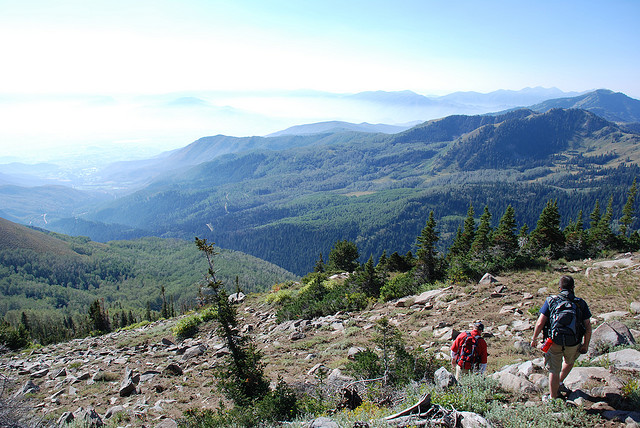
Stretching when doing any physical activity is important to avoid muscle cramping, fatigue and spasms. When hiking long-distances, hikers who don’t stretch could experience lower extremity injuries to their calves, hamstrings or buttocks in the long run. They also run the risk of straining muscles when hiking up or down big steps. This guide is meant for those on a long hike; each stretch can be done on the trail.
I spoke to Marisa Brunett, Regional Vice President for Sports Medicine with CORA health services and certified athletic trainer working through the National Athletic Trainers’ Association (NATA). She recommended a few stretches that hikers can do along the trail and I’ve included photo-diagrams of each below.
Important: With each of these stretches, keeping adequately hydrated is essential to their effectiveness. Getting enough water will replace lost electrolyte fluid and help with cramping and fatigue.
To stretch hamstrings:
Stand up straight in one spot with legs shoulder width apart, then bend straight over. Do not bounce. Hold the stretch for a good count of 15 to 20 seconds. On a nice, big sized rock, stretch with your foot on the rock and bend forward. Again, make sure not to bounce on this or any other stretch.
To stretch quadriceps:
You can do a standing quad stretch anywhere along the trail. Hold onto a tree for balance. Stand upright, bend your right knee backward first, behind your back – grab your right ankle with your right hand and pull up toward the sky. Your leg should be straight behind you, not to your side.
To stretch calves:
Stand an arm’s length away from a tree with both feet pointing straight at the tree. Then take a good step back and plant one foot flat on the ground still pointing straight at the tree. Bending your front leg, lean into the tree with your upper body until you feel your calf in the back leg being stretched. Step back farther with the foot you want to stretch if you don’t feel anything. To get deeper into the calf muscle, bend the knee a little to get that back stretch.
To stretch your back muscles:
Do a standing extension stretch. Standing upright, put your hands in the small of your back and lean backwards. Do a flexion stretch known as the cat position. Wrap your arms around a tree and arch your back up like a cat. Do a sitting stretch. Find a log and sit on the edge of it. Slowly slide your hands down the edge to grab your ankles. Keep your chin tucked into your chest.
To stretch gluteals:
Sit on a flat surface like a flat rock or level piece of land. Bend your knee, put your foot on the opposite side of your other leg and pull it up toward your chest.
To stretch upper neck:
Roll your head to loosen up your muscles. Then tuck your chin in toward your chest. Try to make a double chin. Then do a lateral side bend. Pull your head with your hands to one side then to the other, then front and back.
If you do experience muscle spasms (known as charlie-horses) especially in the calf area, make sure to get hydrated and pull up to a tree to gently go into calf muscle exercises mentioned above.
For external resources, Brunett recommends Bob Anderson’s Stretching Techniques. It’s a complete guide on various stretches of multiple muscles with diagrams.
For the trail, you should be stretching any area that you feel gets sore as the hike goes on. This guide highlighted the bigger muscle groups like quads and hamstrings, but if you have questions about a specific muscle and proper stretching, don’t hesitate to comment with your questions. Thanks to Marisa Brunett for her advice who continually stresses the importance of staying hydrated.
For expert advice on preparing for a long-distance hike check out OutdoorHub’s article with Jackie McDonnell.

 Your Privacy Choices
Your Privacy Choices







 The
The